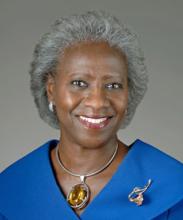
March, 2019
DR. VALANTINE'S FOOD FOR THOUGHT

Hannah A. Valantine, MD
Chief Officer for Scientific Workforce Diversity
Perhaps more so than my previous newsletters, this month's selection of articles has a central theme: the significant role systems play in our lives as scientists. Despite our everyday work lives in the lab or office or wherever we think about science, there is a larger order that sets the tone for this work. Here at NIH, we are thinking hard about the influence of workplace climate and societal attitudes that affect us all, whether we recognize it or not. Check out the articles below, and you'll see just what I mean.
"Ally" is a Verb
The Oxford dictionary defines an ally as "a person or organization that cooperates with or helps another," but it is also a verb, calling for action. That's according to one of six male scientists who are featured in a set of interviews about how men need to be part of the drive for gender equity in biomedicine. Read about what the other five say about calling out bias when they see it, saying no to "manels," and stepping back and listening.
"We're Losing that Talent"
NIH is in a unique position to help eliminate the gender gap in scientific leadership, but "This shouldn't just fall on the shoulders of the women to fix the problem,' said NIH director Dr. Francis Collins recently on the PBS NewsHour. His statement was unambiguous – gender equity, especially at the top levels of science – is key to ending harassment and keeping women in science. The solution requires a systematic and integrated approach, underscored by transparency and accountability. Read about what NIH is doing to end harassment at NIH and beyond.
Survey Suggests Physician Burnout Decreasing
A physician's life is a busy one, and it has become even more hectic with the arrival of online everything, including electronic health records. Sweeping changes in health care over the past few years have introduced more uncertainty and substantial rates of physician burnout. But according to a new survey, there is some reason for optimism. Because the survey was anonymous, we can't say whether there are differences for women and men, or for individuals from underrepresented groups. But one thing seems clear: the interventions that likely will have the most impact are those that target organizational change, not individuals.
Who's Doing the Talking? It Matters
When asked to draw a scientists, most children draw a man. Although these depictions of scientists have become more gender diverse over time, as children grow older, most still link science with men. Unfortunately, these mostly implicit biases persist through adulthood. Women scientists struggle to be recognized and remain out of "view" when scientific conference organizers look for invited speakers. Excuses no more: several women scientists in a range of fields have culled major female talent into online searchable databases.
What Does it Mean to be a Sponsor?
Good mentorship is vital for success in science and medicine. But it's not enough to have an excellent mentor to help his or her mentee solve challenging problems related to both complex scientific problems and career-related choices. Sponsors – who intentionally open doors toward career advancement – are distinct from mentors, although mentors can be sponsors if they are highly placed and well-connected. Sponsorship might take the shape of nominating an individual for a major award, or recommending her or him to a search committee. Other sponsor actions include anything that dissuades a sponsoree from underestimating his or her own talents, but that refrains from "benevolent sexism." Connecting a scientist to influential networks is also a key element. This series of faculty interviews reveals several key observations about what makes sponsorship work well.

The links above are pulled from the top news articles trending on the subject of diversity in science and technology.
The stories selected are not a reflection of the views of the National Institutes of Health.

